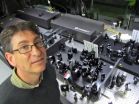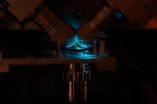(Press-News.org) EUGENE, Ore. -- (Aug. 8, 2011) -- Shape and alignment are everything. How nanometer-sized pieces fit together into a whole structure determines how well a living cell or an artificially fabricated device performs. A new method to help understand and predict such structure has arrived with the successful use a new imaging tool.
Coupling laser-driven, two-dimensional fluorescence imaging and high-performance computer modeling, a six-member team -- led by University of Oregon chemist Andrew H. Marcus and Harvard University chemist Alan Aspuru-Guzik -- solved the conformation of self-assembled porphyrin molecules in a biological membrane.
Porphyrins are organic compounds that are ubiquitous in living things. They carry mobile electrical charges that can hop from molecule-to-molecule and allow for nanoscale communications and energy transfer. They are also building blocks in nanodevices.
The new technique -- phase-modulation 2D fluorescence spectroscopy -- is detailed in a paper scheduled to appear online this week ahead of regular publication in the Proceedings of the National Academy of Sciences. The breakthrough skirts the often-needed step of obtaining crystals of molecules that are being studied, said Marcus, a member of the Oregon Center for Optics, Materials Science Institute and Institute of Molecular Biology. Most functional biological molecules don't easily form crystals.
"Our technique is a workable way to determine how macromolecular objects assemble and form the structures they will in biological environments," Marcus said. "It's robust and will provide a means to study biological protein-nucleic acid interactions."
Work already is underway to modify the experimental instrumentation in the UO's stable and temperature-controlled High Stability Optics Lab to apply the research on DNA replication machinery -- one category of the best-known macromolecular complexes, which consist of nucleic acids and proteins that must be properly aligned to function correctly. "It's a strategy that will allow us to do two things: Look at these complexes one molecule at a time, and perform experiments at short ultraviolet wavelengths to look at DNA problems," he said.
In addition, the approach should be useful to materials scientists striving to understand and harness the necessary conformation of polymers used in the production of nanoscale devices. "In biology, large molecules assemble to form very complex structures that all work together like a machine," Marcus said. "The way these nanoscale structures form and become functional is an actively pursued question."
The technique builds on earlier versions of two-dimensional (2D) optical spectroscopy that emerged in efforts to get around limitations involved in applying X-ray crystallography and nuclear magnetic resonance to such research. The previous 2D approaches depended on the detection of transmitted signals but lacked the desired sensitivity.
The new approach can be combined with single-molecule fluorescence microscopy to allow for research at the tiniest of scales to date, Marcus said. "With fluorescence, you can see and measure what happens one molecule at time. We expect this approach will allow us to look at individual molecular assemblies."
INFORMATION:
Oregon Nanoscience and Microtechnologies Institute (ONAMI), the National Science Foundation and U.S. Department of Energy supported the research. Marcus is a researcher in ONAMI, a collaboration involving the UO, Oregon State University, Oregon Health and Science University, Portland State University, the Pacific Northwest National Laboratory, the state of Oregon and private industry.
The laboratory where the laser work opened in 2005, built with a $510,500 grant from the M.J. Murdock Charitable Trust and a $600,000 investment by the UO. Initially named the Laboratory for Quantum Control as part of the UO's Center for Optics, the basement lab allows researchers to probe and control the behavior of atoms, semiconductors and nanometer-thin metal films.
Geoffrey A. Lott, who earned a doctorate at the UO and is now with Boise Technology Inc. in Nampa, Idaho, and Alejandro Perdomo-Ortiz, a doctoral student in Harvard's department of chemistry and chemical biology, were lead authors on the paper. Additional co-authors were James K. Utterback, an UO undergraduate student in physics and 2009 Barry M. Goldwater Scholarship recipient, and Julia R. Widom, a UO doctoral student and a 2010 recipient of a Rosario Haugland Chemistry Graduate Research Fellowship.
About the University of Oregon
The University of Oregon is among the 108 institutions chosen from 4,633 U.S. universities for top-tier designation of "Very High Research Activity" in the 2010 Carnegie Classification of Institutions of Higher Education. The UO also is one of two Pacific Northwest members of the Association of American Universities.
Links:
Marcus faculty page:
http://chemistry.uoregon.edu/fac.html?marcus
Alan Aspuru-Guzik:
http://aspuru.unix.fas.harvard.edu/About/
Oregon Center for Optics:
http://oco.uoregon.edu/
Materials Science Institute:
http://materialscience.uoregon.edu/
Institute of Molecular Biology:
http://www.molbio.uoregon.edu/
ONAMI:
http://onami.us/index.php/index.php
UO Science on Facebook:
http://www.facebook.com/UniversityOfOregonScience
Biology, materials science get a boost from robust imaging tool
University of Oregon and Harvard collaborators give a new view of macromolecular systems
2011-08-09
ELSE PRESS RELEASES FROM THIS DATE:
Guam researcher studies Mount Pinatubo ecosystem recovery
2011-08-09
University of Guam ecologist Thomas Marler recently mobilized efforts to characterize the vegetation that has recovered following the eruption of Mount Pinatubo, Philippines. "My interest was sparked by the paradox that this volcano's cataclysmic 1991 eruption was so powerful it changed global climate, yet after a full 15 years the biology of the recovering ecosystem had not been studied," said Marler.
The void of research motivated the Guam ecologist to spend a majority of 2006 conducting botanical surveys on the mountain. Marler then teamed up with University of Washington ...
Heavy metal -- in and around the lakes
2011-08-09
Heavy metal pollution of lakes has a seriously detrimental impact on people and ecosystems that rely on such bodies of water. According to a study published in the current issue of Interdisciplinary Environmental Review, researchers have focused on the physicochemical properties and toxicology of water from and around Thane City of Maharashtra.
Environmental chemist Pravin Singare of Bhavan's College, in Mumbai, and colleagues highlight the fact that fresh water bodies all over the world are becoming increasingly polluted day by day and that this represents a growing ...
Improved radical surgery techniques provide positive outcomes for bladder cancer patients
2011-08-09
Bladder cancer patients who have radical surgery at university hospitals can benefit from excellent local control of the disease, acceptable clinical outcomes and low death rates, according to research in the August issue of the urology journal BJUI.
Researchers studied 2,287 patients who had radical cystectomy surgery, where the bladder is removed, together with nearby tissue and organs as required. The surgery was performed at eight Canadian academic centres between 1998 and 2008.
The study found that there were three independent factors, apart from pathological ...
Live from the scene: Biochemistry in action
2011-08-09
Researchers can now watch molecules move in living cells, literally millisecond by millisecond, thanks to a new microscope developed by scientists at the European Molecular Biology Laboratory (EMBL) in Heidelberg, Germany. Published online today in Nature Biotechnology, the new technique provides insights into processes that were so far invisible.
By combining light-sheet microscopy and single molecule spectroscopy, the new microscope can record the fluorescence of every pixel within view, and take snapshots at intervals of less than one millisecond. With it, scientists ...
'Paranoia' about rivals alters insect mating behavior
2011-08-09
Scientists at the University of Liverpool have found that male fruitflies experience a type of 'paranoia' in the presence of another male, which doubles the length of time they mate with a female, despite the female of the species only ever mating with one male.
Females in many species of animal have multiple mates and males have evolved particular reproductive characteristics to ensure their sperm are successful when in competition with the sperm of other males. Adaptations include physical traits that result in increased sperm count, as well as behavioural alterations ...
Schoolchildren can also learn complex subject matters on their own
2011-08-09
Calculating the surface area of Gran Canaria is no easy task for a 14-year-old. It's not simply a question of learning the right formula. Students have to develop a strategy that enables them to put mathematical theory into practice – working out the information that is important and applying the right geometric models and tools. Realizing that the island has an almost circular shape and so its surface area can be approximated using the area of a circle is not as straightforward as it sounds. Are schoolchildren capable of developing these kinds of solutions themselves or ...
Light unlocks fragrance in laboratory
2011-08-09
In Anna Gudmundsdottir's laboratory at the University of Cincinnati, dedicated researchers endeavor to tame the extremely reactive chemicals known as radicals.
Highly reactive radicals are atoms, molecules or ions frantically trying to become something else. Their lifetimes are measured in fractions of seconds and typically occur in the middle of a chain of chemical reactions. They are also known as reactive intermediates. Much of Gudmundsdottir's work has focused on a family of radicals known as triplet nitrenes.
"Triplet nitrenes are reactive intermediates with high ...
Walking around is the simplest way to shorten hospital stay
2011-08-09
A new study from the University of Haifa has found that walking around the ward during hospitalization significantly reduces the length of the older patient's stay. "Given the over-occupancy of many hospitals, this finding can be of great importance," the researchers stated.
Walking around the ward during hospitalization reduces the length of geriatric patients' stay in internal wards. This has been shown in a new study by Dr. Efrat Shadmi and Dr. Anna Zisberg of the University of Haifa's Department of Nursing, funded by the Israeli Science Foundation and published in ...
Many top US scientists wish they had more children
2011-08-09
Nearly half of all women scientists and one-quarter of male scientists at the nation's top research universities said their career has kept them from having as many children as they had wanted, according to a new study by Rice University and Southern Methodist University (SMU).
The study, "Scientists Want More Children," was authored by sociologists Elaine Howard Ecklund of Rice and Anne Lincoln of SMU and appears in the current issue of the journal PLoS ONE.
For the past three years, Ecklund and Lincoln have been studying what junior and senior scientists in physics, ...
Technology reveals citrus greening-infected trees
2011-08-09
U.S. Department of Agriculture (USDA) scientists are using a technology known as "Fourier transform infrared-attenuated total reflection" (FTIR-ATR) spectroscopy to rapidly identify with 95 percent accuracy citrus plant leaves infected with the devastating disease known as citrus greening.
Scientists from the Agricultural Research Service (ARS) Subtropical Plant Pathology Research Unit in Fort Pierce, Fla., and the agency's Quality and Safety Assessment Research Unit in Athens, Ga., collaborated on the use of FTIR-ATR spectroscopy to identify citrus greening in plants. ...
LAST 30 PRESS RELEASES:
What causes some people’s gut microbes to produce high alcohol levels?
Global study reveals widespread burning of plastic for heating and cooking
MIT study shows pills that communicate from the stomach could improve medication adherence
Searching for the centromere: diversity in pathways key for cell division
Behind nature’s blueprints
Researchers search for why some people’s gut microbes produce high alcohol levels
Researchers find promising new way to boost the immune response to cancer
Coffee as a staining agent substitute in electron microscopy
Revealing the diversity of olfactory receptors in hagfish and its implications for early vertebrate evolution
Development of an ultrasonic sensor capable of cuffless, non-invasive blood pressure measurement
Longer treatment with medications for opioid use disorder is associated with greater probability of survival
Strategy over morality can help conservation campaigns reduce ivory demand, research shows
Rising temperatures reshape microbial carbon cycling during animal carcass decomposition in water
Achieving ultra-low-power explosive jumps via locust bio-hybrid muscle actuators
Plant-derived phenolic acids revive the power of tetracycline against drug-resistant bacteria
Cooperation: A costly affair in bacterial social behaviour?
Viruses in wastewater: Silent drivers of pollution removal and antibiotic resistance
Sub-iethal water disinfection may accelerate the spread of antibiotic resistance
Three in four new Australian moms struggle with body image
Post-stroke injection protects the brain in preclinical study
Cardiovascular risk score predicts multiple eye diseases
Health: estimated one in ten British adults used or interested in GLP-1 medications for weight loss
Exercise to treat depression yields similar results to therapy
Whooping cough vaccination for pregnant women strengthens babies’ immune system
Dramatic decline in new cases of orphanhood in Uganda driven by HIV treatment and prevention programs
Stopping weight loss drugs linked to weight regain and reversal of heart health markers
Higher intake of food preservatives linked to increased cancer risk
Mass General Brigham–developed cholera vaccine completes phase 1 trial
First experimental validation of a “150-year-old chemical common sense” direct visualization of the molecular structural changes in the ultrafast anthracene [4+4] photocycloaddition reaction
Lack of support for people on weight loss drugs leaves them vulnerable to nutritional deficiencies, say experts
[Press-News.org] Biology, materials science get a boost from robust imaging toolUniversity of Oregon and Harvard collaborators give a new view of macromolecular systems


